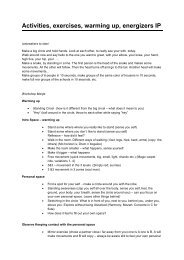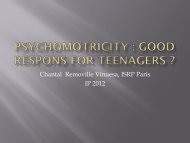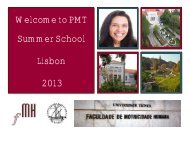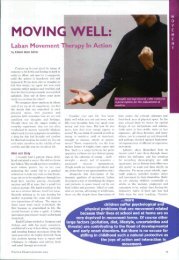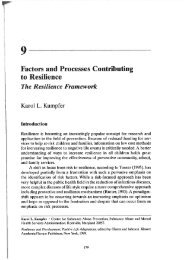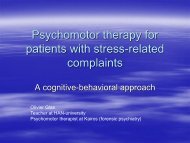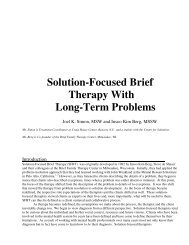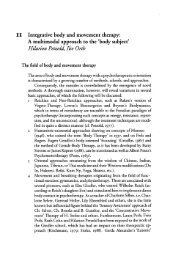Helle Brok (Anette Knudsen), stress and hyporesponse
Helle Brok (Anette Knudsen), stress and hyporesponse
Helle Brok (Anette Knudsen), stress and hyporesponse
Create successful ePaper yourself
Turn your PDF publications into a flip-book with our unique Google optimized e-Paper software.
Hyporespons<br />
the hidden challenge in coping<br />
with <strong>stress</strong>.<br />
By <strong>Helle</strong> <strong>Brok</strong> <strong>and</strong> <strong>Anette</strong> <strong>Knudsen</strong><br />
Studies of Relaxation an Psychomotor Therapy,<br />
VIA University College, Denmark<br />
Mail: hebr@viauc.dk (<strong>Helle</strong>)
Stress <strong>and</strong> body<br />
• In PMT the complaints of the clients are<br />
often related to <strong>stress</strong> (or anxiety).<br />
– There are different ways of helping clients dealing<br />
with these problems.<br />
– A common suggestion is teaching people to relax<br />
or to do physical activity.<br />
• This workshop has focus on optimal tension,<br />
dosering <strong>and</strong> connecting with undertensed<br />
muscles/ressources in the body
Focus in this workshop<br />
• To be aware of the hypo-tension in the<br />
muscles in order to get an optimal tension<br />
in the body.<br />
• To be aware of how activities are precisely<br />
dosed, respecting how much muscular<br />
presence <strong>and</strong> fullness the person can<br />
tolerate to build up.<br />
• To be aware of recourses (psysical,<br />
emotional, social) with start from<br />
undertensed muscles in the body
The underst<strong>and</strong>ing of optimal tension<br />
Optimal tension:<br />
”To react in the most suitable way in every<br />
situation, physical <strong>and</strong> psychological.”<br />
When you do not react in the most suitable way<br />
the reaction will remain in your body <strong>and</strong> mind.<br />
• That means to use the power <strong>and</strong> energy that the situation require, not more, not less,<br />
<strong>and</strong> to restitude after an effort. It is to react on feelings with exactly that energy, that is in<br />
or belongs to, the feeling. Let feelings flow through the body.<br />
• When you don’t react in the most suitable way, the reaction will remain in your body <strong>and</strong><br />
mind – until you react in one or another way, according to the energy, that belongs to the<br />
feeling. Most people have remained reactions in body <strong>and</strong> mind from the childhood <strong>and</strong><br />
youth.
Development of optimal tension in Denmark<br />
Psychiatrists:<br />
Schultz: autogen training<br />
Jacobsen: progressive <strong>and</strong> differented relaxation<br />
Fink: relaxation of the breathing muchels<br />
Carl Rogers:<br />
Client centered therapy<br />
Existentialist philosophy:<br />
Clients experience ’here <strong>and</strong> now’’<br />
Denmark:<br />
Grethe Jørgensen<br />
Ruth Ryborg<br />
Maibritt Schwab<br />
Lisbeth Marcher<br />
Merete H. Brantbjerg<br />
Wilhelm Reich:<br />
Charactor armour –<br />
Muscle armour<br />
Lillemor Johnsen:<br />
Hypothone muscles =<br />
ressources
Lillemor Johnsen<br />
• Through experiences with thous<strong>and</strong> of patients she<br />
discovered they became more diseased, when she<br />
treated only the hypertended muscles.<br />
• She discovered that the muscles in the body could also<br />
be hypo-tensed, <strong>and</strong> when she treated the hypotensed<br />
muscles the patients react in a positive way.<br />
• Conclusion: the hypo-tensed muscles contains the<br />
persons resources, <strong>and</strong> the person has to develop the<br />
resources before she positively is able to release the<br />
defense/the hypertensed muscles.<br />
• She found out how to graduate the tension of the<br />
muscles in a system.
Focus on hypotension<br />
• The aim of changing the focus to the<br />
hypotension in the body is to find<br />
personal resources <strong>and</strong> new ways of<br />
acting out, physical <strong>and</strong> emotional <strong>and</strong><br />
in that way to cope with <strong>stress</strong> <strong>and</strong><br />
anxiety.
Hypo <strong>and</strong> hyper tensed muscles physical<br />
Hypo tension Hyper tension<br />
(Under tension) (over tension)<br />
B4 B3<br />
Non functional<br />
B2 B1<br />
Nearly functional<br />
N<br />
Functional<br />
Consistency of the muscle:<br />
A1 A2<br />
Nearly functional<br />
loose – limp …………………………. firm <strong>and</strong> volume………..……………. ….tense – hard<br />
Quality of the muscle:<br />
whipped cream…draw back ……….firm <strong>and</strong> volume............................push………..board<br />
Reaction velocity (speed)<br />
no reaction………Slow ……………..… elasticity..................................quick....no entrance<br />
A3 A4<br />
Non functional
Hypo <strong>and</strong> hyper tensed muscles phycho-physical<br />
Hypo tension Hyper tension<br />
B4 B3<br />
Non functional<br />
B2 B1<br />
Nearly functional<br />
Ressources<br />
Energy<br />
Contact with the muscles<br />
passive psychological defence active psychological defence<br />
(psychoses/weak self) (neorotic/stronger self)<br />
absent barricated<br />
N<br />
Functional<br />
A1 A2<br />
Nearly functional<br />
A3 A4<br />
Non functional<br />
You can work with musles which are nearly functional <strong>and</strong> funcional (B2, B1,<br />
N, A1, A2)
Hyporesponse is challenging when<br />
dealing with <strong>stress</strong><br />
• The areas that have given up do not dem<strong>and</strong><br />
attention in the way that, for instance, tight<br />
shoulders would.<br />
• It is easy to overlook the body’s signals that<br />
work by absence.<br />
• Learning how to relax does not change this<br />
dynamic.
Ressource oriented skilltraining<br />
supporting a presence here <strong>and</strong> now<br />
• Flexibility<br />
• Centering<br />
• Grounding<br />
• Boundaries<br />
• Containment<br />
• Orientation <strong>and</strong> the ability to regulate contact<br />
• Concrete sensing of the body will maintain a focus on<br />
myself<br />
• Hyporesponse in muscles that are connected to basic presence <strong>and</strong> coping skills will lead to these<br />
skills weakened, distanced <strong>and</strong> vulnerable to external pressure as well as internal rise. Increased<br />
external pressure will typically strengthen a hyporesponsive strategy. We cope by distancing<br />
ourselves or distancing parts of ourselves. This defensive strategy is a way to try <strong>and</strong> dive beneath<br />
the pressure, a way of escaping it. Within a hyporesonsive strategy there is no way of meeting the<br />
pressure <strong>and</strong> taking a conscious st<strong>and</strong>.
Basic skills that are weakened when in<br />
a state impacted by <strong>hyporesponse</strong><br />
To change it takes:<br />
�learning how to tolerate <strong>and</strong> maintain a level of<br />
presence.<br />
�practicing how to find a level of dosing in an<br />
activity that will build up presence instead of<br />
exhaustion.<br />
�Improving your ability to cope with <strong>stress</strong> begins<br />
with acceptable of your inner capacity –<br />
regardless of size – <strong>and</strong> with supporting both the<br />
need for rest <strong>and</strong> for building <strong>and</strong> maintaining a<br />
level of energy <strong>and</strong> presence.
Increasing presence by building up<br />
• So…….<br />
energy<br />
bodily activities does have an impact on<br />
hyporesponsive muscles –but only as long as<br />
activities are precisely dosed, respecting how<br />
much muscular presence <strong>and</strong> fullness the<br />
person can tolerate to build.
The underst<strong>and</strong>ing of optimal tension in Denmark<br />
The unbalanced muscles represents different ways to<br />
react:<br />
•fight <strong>and</strong> defence (sympaticus) or giving up parasympaticus).<br />
•These reactions can be felt in the consistency of the muscles.<br />
•The unbalanced body has minor energy.<br />
•The unbalanced person has less possibilities of acting out.
The underst<strong>and</strong>ing of optimal tension<br />
Your muscles can be hypertensed or hypotensed<br />
<strong>and</strong> it can be a mirror of your mind.<br />
In your body it will stay as hypertensed or<br />
hypotensed muscles, as well as there can be<br />
vegetative reactions.<br />
In your mind it will stay as an unsolved conflict.<br />
The unbalanced tensions are often established in<br />
the childhood <strong>and</strong> they are mirroring the<br />
personality.
To work with<br />
hypo tensioned muscles<br />
Methods with dosering<br />
• Working with strength <strong>and</strong><br />
strengthen the muscles<br />
• Active impulses with h<strong>and</strong>s<br />
when client is passive<br />
• “Pressing”/holding muscles<br />
• Working with the 3 senses:<br />
tactile sense, proprioceptive<br />
sense <strong>and</strong> vestibular sense<br />
(helping sense integration <strong>and</strong><br />
coordination/”keeping the<br />
body together<br />
To work with<br />
hyper tensioned muscles<br />
• Manual long deep slow<br />
stretching where the client is<br />
passive<br />
• Touching with intension of<br />
relaxing, stretching the muscles<br />
<strong>and</strong> take hypertensions away in<br />
the muscles<br />
• Ask client to use briefing active<br />
to relax<br />
• Everything which is soften the<br />
body<br />
• Passive stretch
Program <strong>Helle</strong> <strong>Brok</strong> -1<br />
Movement floor – contact with part of body<br />
• Intro: move on the floor, awareness of a place in your body with less energy, difficult to get in<br />
touch with, kind of “death” part. Move from this part to get in contact with in<br />
• Music Songbird by Kenny G (Kenny G)<br />
• Intervention: to activate undertensed muscle <strong>and</strong> be aware of <strong>and</strong> connect to it. (as well as<br />
any emotion connected to it)<br />
Movement floor – joy <strong>and</strong> a choice<br />
• Intro: move on floor. Make a conscious choice to move with joy. Connect joy <strong>and</strong> the place<br />
from first movement<br />
• Music; Cursum Perficio by Enya (Watermark)<br />
• Intervention: to make clients aware of choice of attitude, move from pain to joy <strong>and</strong><br />
resources.<br />
2 <strong>and</strong> 2 sharing<br />
Intro; share 2 <strong>and</strong> 2. one listen the other talking, what is your spot, how does it feel physical <strong>and</strong><br />
emotional, did you experience anything new.<br />
Intervention; to support the consciousness, to share open also support the feeling of containing
Program <strong>Helle</strong> <strong>Brok</strong> - 2<br />
Movement st<strong>and</strong>ing, with arms. Space – own room<br />
• Intro: make your own space. With your arms. Be aware how you want to make it, stay in contact with your<br />
self <strong>and</strong> only make it as you feel it feels right. Move from inside – put energy in to the movement<br />
• Music; Breath <strong>and</strong> Begin by Elizabeth Rogers (Breath <strong>and</strong> begin)<br />
• Intervention: to make clients aware of <strong>and</strong> having them make their personal space.<br />
Movement 2 <strong>and</strong> 2 back to back (only group 2)<br />
• Intro: move back to back. Stay with our own pulse <strong>and</strong> own room. What happen when you are in touch<br />
with another person or the music playing, will it take you away. Try stay with your room <strong>and</strong> pulse.<br />
• Music Don’t go breaking my Heart – by Elton John <strong>and</strong> Kicki D<br />
• Intervention: give awareness on what disturb the sense of own room, <strong>and</strong> on if possible to keep own<br />
Movement around in the room, keep your space – meeting others<br />
• Intro: move around the room. What happen when you meet others (emotional, physical, social)<br />
• Music Blue Eyes – Mika (the boy who knew to much)<br />
• Intervention: give awareness on what disturb the sense of own room when meeting others<br />
2 <strong>and</strong> 2 sharing<br />
Intro; share 2 <strong>and</strong> 2. one lisent the other talking, how does your room look, feel <strong>and</strong> sense.<br />
Intervention; to support the consciousness, to share open also support the feeling of containing<br />
(group two shared in own language)
Program <strong>Helle</strong> <strong>Brok</strong> - 3<br />
Movement grounding, move around the room<br />
• Intro: grounding support your sense of being you <strong>and</strong> st<strong>and</strong> by you self. Use the music to stamp, get down<br />
in your knees, move with power<br />
• Music; Falling High – Safri Duo (EX 3,5)<br />
• Intervention: to support the grounding.<br />
Break <strong>and</strong> theory<br />
4 different exercises:<br />
• 2 <strong>and</strong> 2, Hips against each other, give energy – building up energy (both sides)<br />
• 2 <strong>and</strong> 2 – Stretching arm with resistant from the other person. Optimal dosering<br />
• 2 <strong>and</strong> 2 – giving impulse on the spine – getting in touch, dosering <strong>and</strong> flexibility, connect<br />
with parts that are difficult to sense<br />
• Progressive relaxation - building up energy – contact with undertensted muscles



